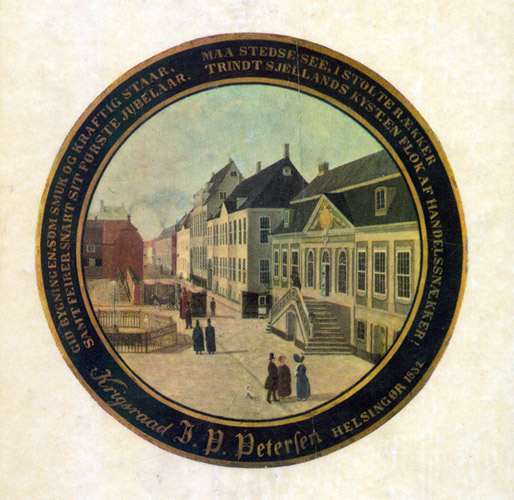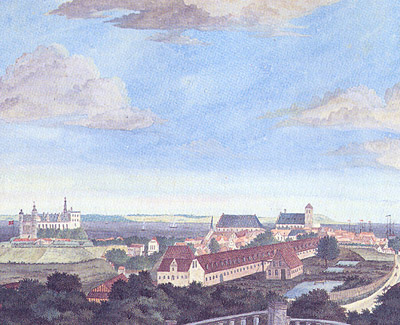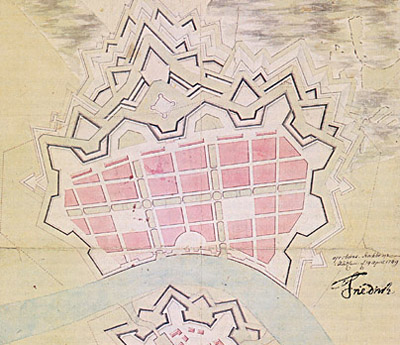| Byer i udvikling

| | 1700-tallet blev en blomstringstid for især Helsingør og Landskrona, hvor der i begge byer blev opført pragtbyggerier i rokokko.
I Helsingør var det Toldkammerbygningen på daværende Toldkammerplads (-nuværende Wiibroes Plads), der var livsnerven i byens økonomiske liv. |
Helsingør

| | Det er rebslagervirksomhedens bygninger, som her dominerer billedet af Helsingør; et godt eksempel på den store erhvervsaktivitet, som prægede Helsingør i sidste halvdel af 1700-tallet.
Øget gennemsejling i Øresund og de stigende indtægter heraf er en væsentlig årsag til byens genopblomstring i den såkaldte florissante periode fra ca.1750-1850.
|
Den florissante by
Helsingør var alvorligt svækket efter krigen og pesten i begyndelsen af 1700-tallet og endnu i 1735 var der kun ca. 3400 indbyggere. Tiden herefter bliver for byen, som for landet som helhed en opgangsperiode, der kommer til at vare århundredet ud. Tidsrummet går under betegnelsen den florissante periode og henviser til en blomstring i forbindelse med stigende udenrigshandel og i mindre grad en udvikling af erhvervslivet.
For Helsingørs vedkommende er der først og fremmest tale om en øget indtjening og omsætning som følge af en stigning i gennemsejladsen i farvandet. Dette kan illustreres med en række nøgletal. I 1500 tallet passerede næppe mere end 300 skibe, i 1600-tallet 1500, mens man omkring 1750 kom op på ca. 5000 skibe årligt, i 1790erne ca. 10.000. Under napoleonskrigene falder antallet katastrofalt, mens man i 1840erne kommer op på over 20.000 skibe årligt. Selve indtægterne af sundtolden, der frem til 1771 gik direkte i kongens private kasse lå i 1730erne på omkring 200.000 rigsdaler årligt i 1780-1790erne på 500-600.000 rigsdaler.

Prospekt af Helsingør | 
Helsingørs profil, 1754 | 
Prospekt fra 1763 | 
Kort fra 1778 |
Erhvervsindberetning
I en forordning af 25.6.1735 blev det pålagt alle stiftsamtmænd at indsende oversigter over de økonomiske forhold i landsdelene og byerne. Interessen er koncentreret om "Hvorudi enhver By og Distrikts Handel, Negocie(Storhandel), Haandtering og Næring bestaar".
I en generel indberetning, forfattet af rådmændene Andreas Becker og G. Hvid, beskrives i korte vendinger byens tilstand, f.eks. at de omkringliggende landbrugsområder producerer korn i et omfang af ca 500 tønder udsæd, at der indføres kød fra Skåne og i det hele taget fødevarer fra andre landsdele. For så vidt er der ingen afgørende ændringer i byens forsyningssituation siden 1500-tallet. Byen kunne altså ikke brødfødes fra oplandet alene.
Af større virksomheder nævnes kun enkelte, et garveri og desuden et tobaksspinderi. De laugsorganiserede fag opregnes og som et tilsyneladende stort problem omtales "... de store indgreb som vederfartes dem af fuskere og efterliggende soldater foruden af garnisonen, som her forefindes, der lettere kan give deres arbejde til fals, end de her skatter og skylde, hvis befales og påbydes". Seks købmænd i byen klager ikke uventet over at bryggere, håndværkere og færgemænd udover deres metier driver ukontrolleret handel og de stiller forslag til en opstramning af reglerne for købmandskab i byen. Måske er det medvirkende til, at der i 1744 oprettes et kræmmerlaug med laugsskrå, i første omgang udelukkende med danske medlemmer.
Merkantilistisk tankegang
En anden indberetning er interessant fordi den kommer med forslag til forbedringer i pagt med tidens merkantilistiske tænkning, hvor man søger at opnå en positiv handelsbalance gennem satsning på egenproduktion og selvforsyning, som oftest i form af monopoler på udenrigshandel og produktionsvirksomhed. Dette synspunkt kommer f.eks. til udtryk i indlæggets paragraf 12:
"Overalt bør man søge ey allene at conservere Pengene i Landet men vel og at faa derhen, at man kan fortiene noget af de fremmede, hvilket er den Gevinst og Fordel, som man med Føye kan sige, at Landet profiterer mest ved."
Selvforsyningen er således det bærende tema, men man bemærker også i paragraf 6 den for tiden karakteristiske sammenkobling af erhvers- og socialpolitik:
"Fattige, som man desto værre finder i stort Tal på Gader og Stræder, kunne forsørges paa den Maade, naar de til Arbejde blev employeret, som allerbest lader sig gjøre, hvor Manufakturer oprettes og fortsættes, der kan baade Gamle og Vanføre fortjene til deres Underholdning og fortjene deres Brød, saavel med at spinde, med at karte Uld og andet Arbejde, som derved i Mængde forefalder; og om det vel i Begyndelsen vilde komme noget besværligt ellet uvandt fore, saa finder det sig med Tiden allerhelst, naar de Fattige beflider den Forskiel udi deres Forflegning ved Arbejdet og naar de til førend ved Bettelstaven haver maattet samle deres Føde."
En sådan politik har man siden Christian 4.s tid praktiseret i de statsmanufakturer, der bl.a. producerer luksustekstiler. Et enkelt lokalt forsøg gøres, da et antal forældreløse børn henvises til geværfabrikken i Hellebæk. Desuden kommer borgermester Tevis Wilde i 1770 med et forslag om at oprette et bomuldsspinderi med de fattige som arbejdskraft, hvilket dog ikke bliver til noget.
Engelske købmænd i Helsingør
En henvisning til fremmede indbyggere i paragraf 8 er meget aktuel, da der i byen hersker mistillid til det voksende antal fremmede, primært engelske købmænd, der profiterer af den voksende gennemsejlads og handel i tiden. De overtog størstedelen af handelen med engelske skibe, vægrede sig under dække af konsulær status ved at betale skat til byen og havde problemer med det i 1744 oprettede kræmmerlaug.
Et interessant eksempel er skibskaptajn John Daniel Belfour, der i 1786 ønsker at nedsætte sig som handlende i byen og søger om optagelse i kræmmerlauget. Det nægtes han, men ansøger så kancelliet om ret til at drive handel udenfor lauget. Det afvises, men centralmagten befaler hans optagelse i lauget, efter han har taget borgerskab, hvilket så sker i 1787.
Belfour er en interessant skikkelse fordi han ikke blot holder sig til handelen, men også investerer produktivt i bl.a. et geneverbrænderi og et garveri. Brænderivirksomhed var et fribytterområde, fordi mange, der også var organiseret i andre laug udøvede denne virksomhed. Belfour går grundigt til værks, indkalder hollandske specialister og opnår et betydeligt lån fra staten. Virksomheden går godt, man når i en enkelt måned, i november 1795 op på at sælge 21.536 potter og succesen fortsætter trods det at brændevinsbrænderne i Helsingør og Hillerød klager over ham i 1799.
Belfour var en virksom herre, der ikke lod sig stoppe af laugenes modstand på dette og andre områder.
Købmand Claessen
Købmand Jean Jacob Claessen var ud af en rig slægt, han far nævnes således i 1756 som den eneste i byen, der ejede egne skibe til udenlandsfart, og ligesom denne giftede han sig ind i en anden fremtrædende familie i byen, van Deurs-familien. I 1784 ansøger han om at anlægge et skibsværft med tilhørende ankersmedie og reberbane. Skibsværftet bliver ikke til noget, men interessant er det, at Claessen opnår særstilling i forhold til både smede- og rebslagerlauget, som på det tidspunkt end ikke forefandtes i Helsingør. Claessen havde endvidere planer om et større havneanlæg, der kunne fremme fjernhandelen, men staten ønsker ikke at støtte denne virksomhed.
I 1764-67 anlægges den første egentlig havn, idet man forlænger den eksisterende skibsbro, tilføjer en arm og tillige bygger en nordre arm. En udvidelse bliver først en realitet omkring 1824.

Havnen og Toldkammeret |
Nye initiativer
Af andre tidlige industrivirksomheder i århundredet kan nævnes lakfabrikker, en hårdugs- og vatfabrik, en stivelse- og pudderfabrik(1785), et sæbesyderi (1790), et eddikebryggeri og et tobaksspinderi(1793). Ingen af disse får dog varig betydning i modsætning til et par sukkerraffinaderier, der opføres fra ca. 1760-70, og hvoraf Adam Späths smukke rokokobygning ved Svingelport endnu forefindes, som et eksempel på tidligt erhvervsbyggeri.

Sukkerraffinaderi |
Havnefrontens palæer
Den stigende aktivitet og omsætning hen imod midten af 1700-tallet satte på forskellig vis sit præg på byen. Især på havnefronten. I årene 1740-42 blev der således opført et nyt Øresund Toldkammer på den daværende Toldkammerplads (nuværende Wiibroes Plads).
Det blev et pragtbyggeri i en blanding af barok og rokoko udformet af en ukendt arkitekt, N. Basse. Bygningen var placeret på hjørnet af forlængelsen af Strandgade og Sophie Brahesgade. På grund af Sundtoldens ophævelse i 1857 og en havneudvidelse omkring 1860 blev pragtbyggeriet, desværre, nedrevet.
Halvdelen af bygningen og dens forplads ville i dag rage ud over Havnegade og lidt ud i havnebassinet. Tilbage står et mindre sandstensløveornament fra 1829 og en rest af et af facadens vinduesornamenter på museumsinspektør Lars Bjørn Madsens kontor i Klarergården tæt ved Wiibroes Plads i Strandgade.
Den øgede velstand kan endnu iagttages i det omfattende byggeri af nye, store privathuse og handelspalæer rundt omkring i byen. F.eks. på den nuværende Havneplads ved Helsingør Station.

Rasmussens Gård 1780 | 
Det Claessenske Palæ 1791 | 
Stephan Hansens Palæ 1760 | 
Toldkammerpladsen | 
Øresunds Toldkammeret 1742 |

Toldkammermaleri |
Færgemænd og værtshuse
Den florissante periode gav også økonomisk fremgang for Helsingørs mange færgemænd og værtshusejere. I Helsingørs "nye" gade, Strandgades sydligste del, kan man stadigvæk se en hel del af disse solidt opførte bindningsværkshuse. I 1970,erne opstod der stor interesse for at bevare og restaurere disse historiske huse. F.ex. værsthusene "Ankeret" i Strandgade 27 og og værtshuset "Norske Løve" i Strandgade 19-21.

Bindningsværkshus Helsingør | 
Strandgade 19 Restaurering 1 | 
Strandgade 19 Restaurering 2 | 
Strandgade 19 Restaurering 3 |
Landskrona

| | De skånske byer var små i forhold til de sjællandske. Men i 1749 blev der i Landskrona satset på en omfattende byplan. Den tog bl.a.udgangspunkt i et nyt militært befæstningsanlæg og betød nedrivning af en gotisk katedral med næsten samme størrelse som Lunds Domkirkes imponerende dimensioner.
Landskrona fik en stil efter 1700-talets ideal, men den totale visionen blev ikke virkeliggjort. |
Byerne - Landskrona
Ikke bare det skånske land var kommet bagud i udviklingen. Det samme gjaldt også de skånske byer. Man får et fingerpeg om byernes indbyrdes betydning som købstæder, fordi Linné nævner antallet af borgere (købmænd) i hver by. Malmö havde 350 stk., Lund 196, Landskrona 150, Helsingborg 130 og Ängelholm 70-80. Malmö var i 1750´erne den eneste by som Linné så som betydende.
Landskronas udvikling
I Landskrona beundrede Linné den store og smukke kirke. ”som nu skulle formindskes til fordel for det nye fæstningsværk”. Man havde ved denne tid opfrisket idéen om at videreudvikle Landskrona. Linné beskrev dette foretagende i sin Rejse i Skåne:
”… nu bygges stengader ud i selve havet på den sydvestlige og vestlige side. Mellem disse skal kvarterene fyldes op og bebygges og byen funderes, så at skibene kan fortøje ved kaj langs med husene i en sikker havn. Dette er et værk som ligner Herculis og som ikke af andre end konger og potentater kan efterlignes.”

Landskronas byplan 1749 | 
Landskronas befæstning | 
Borgmesterhuset i Landskrona |
Ny byplan
Den svenske rigsdag havde i 1747 besluttet at byen igen skulle befæstes med et nyt stærkt citadel på den lille ø Gråen ud for Landskrona. Fra denne ø skulle et befæstningsværk beskytte havnen og den nye by, som skulle bygges syd for den gamle. I 1749 havde Fredrik I godkendt den nye byplan, som denne gang havde en rektangulær form.
Eftersom man byggede store dele af byen udenfor strandlinien skulle et system af kanaler dræne området. Kanalerne byggedes efter hollandsk forbillede, da man anlagde en gade mellem husene og kanalen, ligesom i Nyhavn i København. Slotsarkitekten Carl Hårleman fra Stockholm prægede udformningen af bygningerne.
Kirken skiftes
Hårleman var også manden bag den nye kirke, som påbegyndtes i 1754 men indviedes dog først i 1788. Kirken fik navnet Sofia Albertina efter Gustav 3.s søster.
Den gamle gotiske kirke, som var næsten lige så stor som Lunds domkirke, blev nedrevet. Man mente, at kirken lå for tæt på den gamle fæstning, og man var bange for at en fjende kunne okkupere kirken og derfra beskyde fæstningen. Desuden var kirken forfalden og indeholdt masser af bygningsmateriale, som kunne bruges til nye projekter. Både strategiske og økonomiske årsager lå bag nedrivningen af en af Nordens pragtfuldeste gotiske kirker.

Den gamle kirke i Landskrona | 
Den nye kirke i Landskrona | 
Den nye kirke i Landskrona |
Projektet stoppes
Arbejdet med det nye Landskrona trak ud og blev samtidigt alt for dyrt. Da Sveriges finanser blev anstrengte under krigen mod Rusland i 1788, nedlagdes projektet, og den nye by blev kun halvt fuldendt. Til trods for at planerne ikke fuldførtes fik Landskrona et tydeligt 1700-talspræg, og i dag finder man adskillige bygninger fra den tid, da man prøvede at skabe en ny moderne by i tidens ånd. |